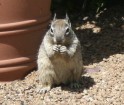 |
| Eggs! |
One of Cindy's Master Gardener friends gave her some eggs from his family's farm in La Mesa.
I was amazed at how beautiful these eggs were, especially the greenish-blue ones. They were delicious, too, with large yolks that were so intensely yellow they were almost orange.
We wondered if such eggs had inspired Dr. Seuss's Green Eggs And Ham, but according to a Wikipedia
article, it was inspired by a bet between Dr. Seuss and his publisher, Bennet Cerf, that he could not write a book using as few as 50 words.
 |
| Cock-A-Doodle |
The green eggs started Cindy and me wondering what breed of chicken produces green eggs. That led us to
Henderson's Handy-Dandy Chicken Chart, which indicates that the two most likely breeds are the Ameraucana and the Arucana breeds. The former lays various shades of blue and green egg and the latter lays only blue, so these eggs were most likely from Ameraucana chickens.
Dominick, who supplied the eggs, says the blue and green ones come from Ameraucana hens, the white ones are from Anconas and the brown eggs are from Barred Plymouth Rock hens.
Looking at pictures of Ameraucana chickens led us to an "ah ha" moment: the Ameraucana roosters pictured were absolute ringers for
Cock-A-Doodle, the very handsome rooster who had lived in our shrubbery for about a year. We had always wondered what breed he was, so I'm thinking we may have identified it.
With the help of the hens in his new harem, Cock-A-Doodle may have helped several new generations of chickens produce lovely green eggs.

















